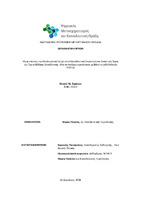| dc.contributor.advisor | Τζελέπη, Μαρία | |
| dc.contributor.author | Ζαχάκου, Θεανώ | |
| dc.date.accessioned | 2024-05-28T08:29:50Z | |
| dc.date.available | 2024-05-28T08:29:50Z | |
| dc.date.issued | 2024-04-10 | |
| dc.identifier.uri | https://polynoe.lib.uniwa.gr/xmlui/handle/11400/6794 | |
| dc.identifier.uri | http://dx.doi.org/10.26265/polynoe-6629 | |
| dc.description.abstract | Η παρούσα εργασία εκπονήθηκε στα πλαίσια του Διιδρυματικού
Μεταπτυχιακού Προγράμματος Σπουδών «Ψηφιακός Μετασχηματισμός και
Εκπαιδευτική Πράξη» των πανεπιστημιακών ιδρυμάτων ΕΚΠΑ, ΠΑΔΑ και
ΑΣΠΑΙΤΕ.
Ο στόχος της παρούσας εργασίας είναι να διερευνήσει τις δεξιότητες
υπολογιστικής σκέψης που καλλιεργούνται από τους μαθητές, κατά τη
διάρκεια της διαθεματικής προσέγγισης της εκπαιδευτικής ρομποτικής και της
εικαστικής τέχνης στην πρωτοβάθμια εκπαίδευση. Κατά την εκπαιδευτική
παρέμβαση, οι μαθητές με τη βοήθεια της ερευνήτριας θα κατασκευάσουν ένα
μικρό ρομπότ-βοηθό με απώτερο στόχο αυτό να είναι αξιοποιήσιμο από
μαθητές με προβλήματα όρασης, ώστε να κατορθώσουν μέσω αυτού και να
εκφραστούν καλλιτεχνικά μέσω του ζωγραφικού καλλιτεχνικού ρεύματος της
Αναγέννησης.
Για τον σκοπό αυτό οι μαθητές αρχικά θα ενημερωθούν για τα χαρακτηριστικά
του Αναγεννησιακού ρεύματος, ενώ κατά τη διάρκεια της παρέμβασης θα
προτείνουν, διατυπώσουν και δημιουργήσουν την καλλιτεχνική ρομποτική
κατασκευή τους. Με την ολοκλήρωση της κατασκευής θα την αξιολογήσουν,
ώστε να διαπιστώσουν αν τελικά αυτή είναι όσο το δυνατόν πιο κοντά γίνεται
στις ανάγκες των παιδιών με προβλήματα όρασης που επιθυμούν να
ζωγραφίσουν. Ταυτοχρόνως, κατά τη διάρκεια της εκπαιδευτικής αυτής
διαδικασίας θα διερευνηθεί κατά πόσο οι μαθητές καλλιέργησαν
συγκεκριμένες δεξιότητες υπολογιστικής σκέψης και σε ποια στάδια
καλλιεργήθηκε κάθε μία από αυτές.
Οι συμμετέχοντες ήταν έξι (6) παιδιά που φοιτούν στην Πέμπτη (Ε) τάξη
Δημοτικού σχολείου. Άλλοτε δούλευαν σαν μια ομάδα και άλλοτε με
αρμοδιότητες σε υποομάδες.
Η ερευνητική προσέγγιση ήταν ποιοτική, και ο σχεδιασμός των
δραστηριοτήτων της έρευνας βασίστηκε στη μεθοδολογία FERTILE. Η
επεξεργασία των δεδομένων καλύφθηκε με τη μέθοδο της θεματικής
ανάλυσης.
Τα αποτελέσματα ανέδειξαν ότι η ΕΡ συνέβαλε στην ενίσχυση των δεξιοτήτων
ΥΣ και στην αύξηση κινήτρων και ενδιαφέροντος για το μάθημα.
Τα συμπεράσματα που προέκυψαν ενισχύουν το ζήτημα της ενσωμάτωσης
της Εκπαιδευτικής Ρομποτικής στις εικαστικές τέχνες. Επισημαίνεται, τέλος,
πως απαιτείται επιπλέον έρευνα και εμβάθυνση για την καλύτερη κατανόηση
της συμβολής της εκπαιδευτικής ρομποτικής στις τέχνες. | el |
| dc.format.extent | 129 | el |
| dc.language.iso | el | el |
| dc.publisher | Πανεπιστήμιο Δυτικής Αττικής | el |
| dc.publisher | Εθνικό και Καποδιστριακό Πανεπιστήμιο Αθηνών | el |
| dc.publisher | Ανώτατη Σχολή Παιδαγωγικής και Τεχνολογικής Εκπαίδευσης (Α.Σ.ΠΑΙ.Τ.Ε.) | el |
| dc.rights | Attribution-NonCommercial-NoDerivatives 4.0 Διεθνές | * |
| dc.rights.uri | http://creativecommons.org/licenses/by-nc-nd/4.0/ | * |
| dc.subject | Ζωγραφική | el |
| dc.subject | Άτομα με προβλήματα όρασης | el |
| dc.subject | Υπολογιστική σκέψη | el |
| dc.subject | Lego | el |
| dc.subject | Scratch | el |
| dc.title | Εξερευνώντας την υπολογιστική σκέψη στην εκπαιδευτική ρομποτική και εικαστική τέχνη της πρωτοβάθμιας εκπαίδευσης: μια καινοτόμος προσέγγιση με βάση τη μεθοδολογία FERTILE | el |
| dc.title.alternative | Exploring computational thinking through education robotics and visual arts course in primary education: An innovative approach based on the FERTILE methodology | el |
| dc.type | Μεταπτυχιακή διπλωματική εργασία | el |
| dc.contributor.committee | Παπανικολάου, Κυπαρισσία | |
| dc.contributor.committee | Karkazis, Panagiotis | |
| dc.contributor.faculty | Σχολή Μηχανικών | el |
| dc.contributor.department | Τμήμα Μηχανικών Πληροφορικής και Υπολογιστών | el |
| dc.contributor.master | Ψηφιακός Μετασχηματισμός και Εκπαιδευτική Πράξη | el |
| dc.description.abstracttranslated | This research was prepared within the framework of the Inter-Institutional Master's Program "Digital Transformation and Educational Practice" of the EKPA, PADA and ASPAITE university institutions. The aim of this paper is to investigate the computational thinking skills developed by students during the interdisciplinary approach of educational robotics and art in primary education. During the intervention, the students, with the help of the researcher, will try to build a small robot- assistant with the ultimate goal that it can be used by primary school students with visual impairments during the art class, so that they can express themselves through the movement of the Renaissance. For the research purposes the students will, first of all, be informed about the characteristics of the Renaissance movement. During the intervention they will discover what is needed to propose, formulate and create their own robot. Upon completion of the construction, they will evaluate it in order to determine whether it is as close as possible to the needs of visually impaired children who wish to paint while at school. At the same time, it will be investigated whether the students developed specific computational thinking skills set by the researcher and at which stage. The participants were six (6) children attending year 5 of Primary school. Sometimes they worked as a team and sometimes with sub-group responsibilities. The research approach was qualitative and the design of research activities was based on the FERTILE methodology. The processing of the data was done using the thematic analysis method. The results showed that the educational robotics (ER) contributed to the enhancement of computational thinking (CT) skills and to the increase of the students’ motivation and interest in the art class. The conclusions drawn strengthen the question of the integration of Educational Robotics in the arts. Finally, it is pointed out that additional research and deepening is required for a better understanding of the contribution of educational robotics in arts. | el |


